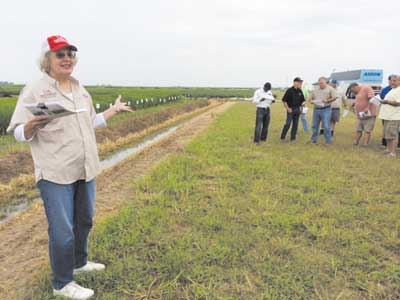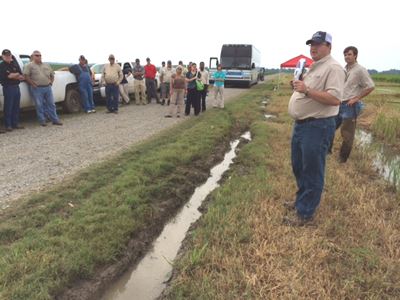|
New Varieties Release Highlights Annual Rice Expo
STUTTGART, ARK.
The University of Arkansas System Division of Agriculture on released two new long grain rice varieties, and showcased a medium grain that could be grown for the breakfast aisle as early as next year – all part of the fourth annual Arkansas Rice Expo.
The Rice Expo, held Friday at the Grand Prairie Center and the Rice Research and Extension Center, celebrates Arkansas’ rank as the nation’s top rice-growing state.
The releases were highlighted during research tours by Division of Agriculture scientists at the Rice Research and Extension Center. There, visitors could stop at seven sites in the fields where the researchers offered advice to producers and explained their findings and prospects for future work.
Long, plump kernels
Rice breeder Karen Moldenhauer reviewed two new varieties being released by the Division of Agriculture, CL172 and LaKast. Both varieties have excellent rough rice yields with good milling yields, Moldenhauer said. Both also have typical southern U.S long-grain cooking quality. CL172 is resistant to a disease called blast in Arkansas conditions similar to the Katy, Kaybonnet and Drew varieties.
LaKast is blast susceptible in Arkansas conditions similar to the Wells and Roy J varieties. “If you can maintain your flood and you don’t grow it where you set yourself up to have a bad blast situation in areas with trees around the field etc., we don’t have a problem with blast on the variety,” Moldenhauer said.

Karen Moldenhauer discusses rice breeding research
with visitors to the Arkansas Rice Expo.
CL172 has grain weight and size similar to the Wells and Roy J varieties and a “nice, long, plump kernel,” Moldenhauer said. LaKast also has a grain weight similar to Wells and a kernel length of 7.6 mm, one of the longest kernels of commercially available cultivars.
“From a quality standpoint, it’s a good variety,” Moldenhauer said of LaKast. “It has had a stable high-yield potential over the last four years in the Arkansas performance trials. In 2010 when it was very hot, it still had a high yield compared to other varieties, yielding about 194 bushels per acre.”
Bound for cereal bowls
Rice breeder Xueyan Sha discussed the medium-grain breeding program and said a promising conventional experimental line 13AR1021 is likely to be released in 2015. “In the last two years in multi-state, multi-location trials, it performed very well,” Sha said. “It has a very good yield potential and very good milling and superior grain quality, which is a big plus for us. So far all the feedback from rice mills and processors, including Kellogg’s, is positive.”
Soil scientist Trent Roberts reviewed nitrogen management and noted the recent expansion around the state of the Division’s N-STaR, Nitrogen Soil Test for Rice, program. “This spring with increased rainfall we had several problems with pre-flood nitrogen management,” said Roberts, who reviewed proper ways to manage pre-flood nitrogen on wet soils. He explained how to use the GreenSeeker, a hand-held crop sensor, “which will allow us to determine midseason nitrogen needs and will be especially beneficial in areas where pre-flood nitrogen was mismanaged.”

Dr. Trent Roberts update visitors about
the N-STaR Nitrogen Soil Test for Rice.
Christopher Henry, an extension water management engineer for the University of Arkansas System Division of Agriculture, explained how farmers can get involved with the state water plan and how the new technology can be used to improve their bottom line. Extension Weed Scientist Bob Scott discussed drift and weed control technologies. Gus Lorenz, an extension entomologist, covered insect management issues and extension’s Jarrod Hardke reviewed rice agronomy issues.
Rice Expo is significant because it “provides opportunity to see the latest research and come and visualize some things rather than just read about it from a book,” said Baker Fullerton, a rice consultant from DeWitt.
He has been attending Rice Expo for many years, he said. He attended to get some updates on the newest advancement in agriculture. ∆
|
|